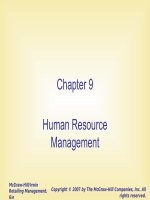Lecture biology (6e) chapter 9 campbell, reece
Bạn đang xem bản rút gọn của tài liệu. Xem và tải ngay bản đầy đủ của tài liệu tại đây (1.03 MB, 69 trang )
CHAPTER 9 CELLULAR
RESPIRATION: HARVESTING
CHEMICAL ENERGY
Section A: The Principles of Energy Harvest
1. Cellular respiration and fermentation are catabolic, energyyielding
pathways
2. Cells recycle the ATP they use for work
3. Redox reactions release energy when electrons move closer to
electronegative atoms
4. Electrons “fall” from organic molecules to oxygen during cellular
respiration
5. The “fall” of electrons during respiration is stepwise, via NAD + and an
electron transport chain
Copyright © 2002 Pearson Education, Inc., publishing as Benjamin Cummings
Introduction
ã Livingiswork.
ã Toperformtheirmany
tasks,cellsrequire
transfusionsofenergy
fromoutsidesources.
ã Inmostecosystems,
energyentersassunlight.
ã Lightenergytrappedin
organicmoleculesis
availabletoboth
photosyntheticorganisms
andothersthateatthem.
Fig.9.1
Copyrightâ2002PearsonEducation,Inc.,publishingasBenjaminCummings
1.Cellularrespirationandfermentationare
catabolic,energyưyieldingpathways
ã Organicmoleculesstoreenergyintheirarrangement
ofatoms.
ã Enzymescatalyzethesystematicdegradationof
organicmoleculesthatarerichinenergytosimpler
wasteproductswithlessenergy.
ã Someofthereleasedenergyisusedtodoworkand
therestisdissipatedasheat.
Copyrightâ2002PearsonEducation,Inc.,publishingasBenjaminCummings
• Metabolic pathways that release the energy stored
in complex organic molecules are catabolic.
• One type of catabolic process, fermentation, leads
to the partial degradation of sugars in the absence
of oxygen.
• A more efficient and widespread catabolic process,
cellular respiration, uses oxygen as a reactant to
complete the breakdown of a variety of organic
molecules.
• Most of the processes in cellular respiration occur in
mitochondria.
Copyright © 2002 Pearson Education, Inc., publishing as Benjamin Cummings
• Cellular respiration is similar to the combustion of
gasoline in an automobile engine.
• The overall process is:
• Organic compounds + O2 > CO2 + H2O + Energy
• Carbohydrates, fats, and proteins can all be used as
the fuel, but it is traditional to start learning with
glucose.
• C6H12O6 + 6O2 > 6CO2 + 6H2O + Energy (ATP + heat)
• The catabolism of glucose is exergonic with a delta
G of 686 kcal per mole of glucose.
• Some of this energy is used to produce ATP that will
perform cellular work.
Copyright © 2002 Pearson Education, Inc., publishing as Benjamin Cummings
2.CellsrecycletheATPtheyuseforwork
ã ATP,adenosinetriphosphate,isthepivotalmolecule
incellularenergetics.
ã Itisthechemicalequivalentofaloadedspring.
ã Theclosepackingofthreenegativelychargedphosphate
groupsisanunstable,energyưstoringarrangement.
ã Lossoftheendphosphategrouprelaxesthespring.
ã Thepriceofmostcellularworkistheconversionof
ATPtoADPandinorganicphosphate(Pi).
ã AnanimalcellregeneratesATPfromADPandPiby
thecatabolismoforganicmolecules.
Copyrightâ2002PearsonEducation,Inc.,publishingasBenjaminCummings
• The transfer of the terminal phosphate group from
ATP to another molecule is phosphorylation.
• This changes the shape of the receiving molecule,
performing work (transport, mechanical, or chemical).
• When the
phosphate
group leaves
the molecule,
the molecule
returns to its
alternate shape.
Fig. 9.2
Copyright © 2002 Pearson Education, Inc., publishing as Benjamin Cummings
3.Redoxreactionsreleaseenergywhen
electronsmoveclosertoelectronegative
atoms
ã Catabolicpathwaysrelocatetheelectronsstoredin
foodmolecules,releasingenergythatisusedto
synthesizeATP.
ã Reactionsthatresultinthetransferofoneormore
electronsfromonereactanttoanotherareoxidationư
reductionreactions,orredoxreactions.
ã Thelossofelectronsiscalledoxidation.
ã Theadditionofelectronsiscalledreduction.
Copyrightâ2002PearsonEducation,Inc.,publishingasBenjaminCummings
• The formation of table salt from sodium and
chloride is a redox reaction.
• Na + Cl > Na+ + Cl
• Here sodium is oxidized and chlorine is reduced (its
charge drops from 0 to 1).
• More generally: Xe + Y > X + Ye
• X, the electron donor, is the reducing agent and
reduces Y.
• Y, the electron recipient, is the oxidizing agent and
oxidizes X.
• Redox reactions require both a donor and acceptor.
Copyright © 2002 Pearson Education, Inc., publishing as Benjamin Cummings
• Redox reactions also occur when the movement of
electrons is not complete but involve a change in
the degree of electron sharing in covalent bonds.
• In the combustion of methane to form water and
carbon dioxide, the nonpolar covalent bonds of
methane (CH) and oxygen (O=O) are converted to
polar covalent bonds (C=O and OH).
Fig. 9.3
Copyright © 2002 Pearson Education, Inc., publishing as Benjamin Cummings
• When these bonds shift from nonpolar to polar, the
electrons move from positions equidistant between
the two atoms for a closer position to oxygen, the
more electronegative atom.
• Oxygen is one of the most potent oxidizing agents.
• An electron looses energy as it shifts from a less
electronegative atom to a more electronegative one.
• A redox reaction that relocates electrons closer to
oxygen releases chemical energy that can do work.
• To reverse the process, energy must be added to
pull an electron away from an atom.
Copyright © 2002 Pearson Education, Inc., publishing as Benjamin Cummings
4.Electronsfallfromorganicmolecules
tooxygenduringcellularrespiration
ã Incellularrespiration,glucoseandotherfuel
moleculesareoxidized,releasingenergy.
ã Inthesummaryequationofcellularrespiration:
C6H12O6+6O2ư>6CO2+6H2O
ã Glucoseisoxidized,oxygenisreduced,andelectrons
loosepotentialenergy.
ã Moleculesthathaveanabundanceofhydrogenare
excellentfuelsbecausetheirbondsareasourceof
hilltopelectronsthatfallclosertooxygen.
Copyrightâ2002PearsonEducation,Inc.,publishingasBenjaminCummings
• The cell has a rich reservoir of electrons associated
with hydrogen, especially in carbohydrates and
fats.
• However, these fuels do not spontaneously
combine with O2 because they lack the activation
energy.
• Enzymes lower the barrier of activation energy,
allowing these fuels to be oxidized slowly.
Copyright © 2002 Pearson Education, Inc., publishing as Benjamin Cummings
5.Thefallofelectronsduringrespiration
isstepwise,viaNAD+andanelectron
transportchain
ã Cellularrespirationdoesnotoxidizeglucoseina
singlestepthattransfersallthehydrogeninthefuel
tooxygenatonetime.
ã Rather,glucoseandotherfuelsarebrokendown
graduallyinaseriesofsteps,eachcatalyzedbya
specificenzyme.
ã Atkeysteps,hydrogenatomsarestrippedfrom
glucoseandpassedfirsttoacoenzyme,likeNAD+
(nicotinamideadeninedinucleotide).
Copyrightâ2002PearsonEducation,Inc.,publishingasBenjaminCummings
• Dehydrogenase enzymes strip two hydrogen atoms
from the fuel (e.g., glucose), pass two electrons
and one proton to NAD+ and release H+.
• HCOH + NAD+ > C=O + NADH + H+
Copyright © 2002 Pearson Education, Inc., publishing as Benjamin Cummings
• This changes the oxidized form, NAD+, to the
reduced form NADH.
• NAD + functions as the oxidizing agent in many of the redox
steps during the catabolism of glucose.
Fig. 9.4
Copyright © 2002 Pearson Education, Inc., publishing as Benjamin Cummings
• The electrons carried by NADH loose very little of
their potential energy in this process.
• This energy is tapped to synthesize ATP as
electrons “fall” from NADH to oxygen.
Copyright © 2002 Pearson Education, Inc., publishing as Benjamin Cummings
• Unlike the explosive release of heat energy that
would occur when H2 and O2 combine, cellular
respiration uses an electron transport chain to
break the fall of electrons to O2 into several steps.
Fig. 9.5
Copyright © 2002 Pearson Education, Inc., publishing as Benjamin Cummings
• The electron transport chain, consisting of several
molecules (primarily proteins), is built into the inner
membrane of a mitochondrion.
• NADH shuttles electrons from food to the “top” of
the chain.
• At the “bottom,” oxygen captures the electrons and
H+ to form water.
• The free energy change from “top” to “bottom” is
53 kcal/mole of NADH.
• Electrons are passed by increasingly electronegative
molecules in the chain until they are caught by
oxygen, the most electronegative.
Copyright © 2002 Pearson Education, Inc., publishing as Benjamin Cummings
CHAPTER 9 CELLULAR
RESPIRATION: HARVESTING
CHEMICAL ENERGY
Section B: The Process of Cellular Respiration
1. Respiration involves glycolysis, the Krebs cycle, and electron transport: an
overview
2. Glycolysis harvests chemical energy by oxidizing glucose to pyruvate: a
closer look
3. The Krebs cycle completes the energyyielding oxidation of organic
molecules: a closer look
4. The inner mitochondrial membrane couples electron transport to ATP
synthesis: a closer look
5. Cellular respiration generates many ATP molecules for each sugar
molecule it oxidizes: a review
Copyright © 2002 Pearson Education, Inc., publishing as Benjamin Cummings
1.Respirationinvolvesglycolysis,theKrebs
cycle,andelectrontransport:
anoverview
ã Respirationoccursinthreemetabolicstages:glycolysis,
theKrebscycle,andtheelectrontransportchainand
oxidative
phosphorylation.
Fig.9.6
Copyrightâ2002PearsonEducation,Inc.,publishingasBenjaminCummings
• Glycolysis occurs in the cytoplasm.
• It begins catabolism by breaking glucose into two
molecules of pyruvate.
• The Krebs cycle occurs in the mitochondrial
matrix.
• It degrades pyruvate to carbon dioxide.
• Several steps in glycolysis and the Krebs cycle
transfer electrons from substrates to NAD+,
forming NADH.
• NADH passes these electrons to the electron
transport chain.
Copyright © 2002 Pearson Education, Inc., publishing as Benjamin Cummings
• In the electron transport chain, the electrons move
from molecule to molecule until they combine with
oxygen and hydrogen ions to form water.
• As they are passed along the chain, the energy
carried by these electrons is stored in the
mitochondrion in a form that can be used to
synthesize ATP via oxidative phosphorylation.
• Oxidative phosphorylation produces almost 90% of the
ATP generated by respiration.
Copyright © 2002 Pearson Education, Inc., publishing as Benjamin Cummings
• Some ATP is also generated in glycolysis and the
Krebs cycle by substratelevel phosphorylation.
• Here an enzyme
transfers a phosphate
group from an
organic molecule
(the substrate)
to ADP, forming
ATP.
Fig. 9.7
Copyright © 2002 Pearson Education, Inc., publishing as Benjamin Cummings
• Respiration uses the small steps in the respiratory
pathway to break the large denomination of energy
contained in glucose into the small change of ATP.
• The quantity of energy in ATP is more appropriate for
the level of work required in the cell.
• Ultimately 38 ATP are produced per mole of
glucose that is degraded to carbon dioxide and
water by respiration.
Copyright © 2002 Pearson Education, Inc., publishing as Benjamin Cummings









